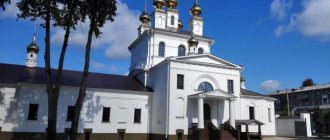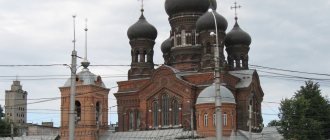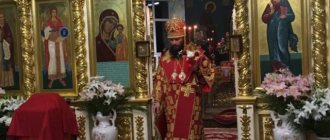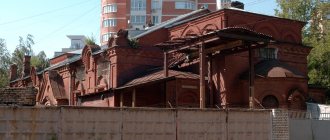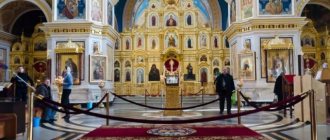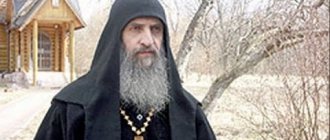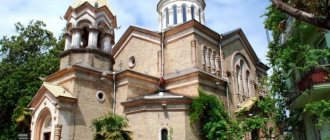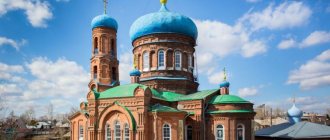Despite the bloody repressions of the 20s and 30s of the last century, which almost destroyed all faith on the territory of the USSR, the Russian Orthodox Church, with God's help, not only survived, but also grew in some areas. Thus, in the 30s, the Ivanovo Metropolis was formed - an ecclesiastical region, which included 3 independent dioceses.
The Metropolis is part of the famous Golden Ring of Russia and has traditionally been Russian Orthodox territory. It is worth visiting its temples and monasteries, both as part of pilgrimage trips and as a cultural event, because there are many historical monuments and cultural heritage sites.
Story
Initially, all the lands (until the 70s of the 11th century), which today made up the metropolis, were part of various dioceses from Pereyaslav to Rostov. In 1299, by decision of the Synod, all parishes in this territory were transferred to the Metropolitan region (later renamed Patriarchal and Synodal).
Transfiguration Cathedral in Ivanovo
In 1742-1744, this region was once again transformed and 2 separate independent units were separated from it - the Vladimir and Kostroma dioceses. The entire Ivanovo region was divided between them, and a little later part of these lands were assigned to the Yaroslavl diocese.
Until the beginning of 1918, the Ivanovo Metropolis did not exist at all as an independent unit. The exact date of formation of this territorial-administrative church unit is not known. It is only known that this first happened in 1934 by the decision of the Holy Synod after the separation of the Ivanovo-Voznesensk province.
The Ivanovo Metropolis then included a number of independent dioceses and vicariates subordinate to them:
- Ivanovskaya;
- Vladimirskaya;
- Yaroslavskaya;
- Kostroma.
However, the metropolis did not last long - already in 1943, during the reorganization of episcopal sees, it was abolished, and dioceses and vicariates were transferred to neighboring ones, if not abolished altogether.
The restoration took place after the collapse of the USSR - only on June 7, 2012, the Holy Synod decided to recreate the Ivanovo Metropolis, the borders of which completely coincided with the administrative borders of the Ivanovo region.
Metropolitan Joseph of Ivanovo-Voznesensk and Vichuga
The metropolis today includes 3 independent dioceses:
- Ivanovo-Voznesenskaya - it includes all parishes located within the administrative boundaries of the city of Ivanovo, as well as adjacent areas (Privolzhsky, Furmansky, etc.). The church unit is governed by Metropolitan Joseph (Makedonov). According to the latest statistics, the diocese covers about 602,000 people through 54 separate parishes.
- Kineshemskaya - it includes the district of the same name in the Ivanovo region, as well as Lukhsky, Zavolzhsky and a number of others. Bishop Hilarion (Kaigorodtsev) governs 58 parishes in this region, and the Russian Orthodox Church covers a population of 228,000.
- Shuyskaya - 71 parishes under the direction of Bishop Matthew (Samkulov) are concentrated here. The population is 231,000 people within the boundaries of the districts of Shuisky, Yuzhsky, Lezhnevsky, etc.
Resurrection Cathedral in Shuya, Ivanovo region
The Metropolis is successfully developing, carries out educational and social work among the population of the Ivanovo region, hosts numerous pilgrimage excursions and takes care of the spiritual life of the population.
Advice! The activities of the metropolis and its news can be found in real time on its website.
Ivanovo-Voznesensk Diocese
The formation of the Ivanovo-Voznesensk diocese, apparently, was a consequence of the creation of January 14. 1929 Ivanovo industrial region, which included Ivanovo-Voznesensk, Vladimir, Kostroma and Yaroslavl provinces. A little earlier, December 27. 1928, a determination was issued for the Deputy Patriarchal Locum Tenens Metropolitan. Sergius (Stragorodsky) and the Provisional Patriarchal Synod on the establishment of church districts in the Patriarchal Church in accordance with the new administrative-territorial division of the country into regions and districts and on the granting of special powers to the bishops of the main cities of church districts (JMP, 1931-1935. P. 218). On March 31 (or November 13), 1929, the former Bishop of Ivanovo-Voznesensk was appointed. Yegoryevsky Bishop sschmch. Pavel (Galkovsky), soon elevated to the rank of archbishop. By the determination of the Deputy Patriarchal Locum Tenens Metropolitan. Sergius (Stragorodsky) and Temporary Priest. Synod 19 Nov. 1930 Archbishop. Pavel was introduced to the small assembly of the Patriarchal Synod (Arch. TsNTs PE. F. 3. Op. 2. D. 6. L. 9).
27 Apr 1934 Deputy Patriarchal Locum Tenens Sergius was given the title “His Beatitude Metropolitan of Moscow and Kolomna.” This event caused a wide response from the Orthodox Church. the clergy of the country, who sent congratulatory telegrams to the High Hierarch. In May-June 1934, Ivanovo-Voznesensk Archbishop. Paul and the diocesan clergy sent Met. Congratulatory addresses to Sergius. From these documents it is possible to approximately determine the territory of the diocese and the number of clergy at this time. All R. In 1934, in the Ivanovo diocese there were at least 21 deanery districts, in particular 7 Shuisky, 5 Teykovsky, Ivanovsky, Lezhnevsky, 5 Seredsky and Rodnikovsky, a separate deanery consisted of the city churches of Ivanovo. The absence of the Kineshma deanery in the Ivanovo diocese is explained by the fact that the north. part of the Ivanovo industrial region. until 1936 it was part of the Kineshma Vicariate of the Kostroma Diocese. Under the congratulatory messages of Metropolitan. Sergius was signed by 92 priests and 8 deacons (Ibid. D. 10. L. 30-33, 63-71). In Ivanovo at the Annunciation Church. There was a community of the same faith, the rector of which was Rev. Nikolai Chesnokov. From the report of the archbishop. Metropolitan Pavel (Galkovsky) Sergius (Stragorodsky) dated May 26, 1934, knows that the Annunciation Church was at that time the cathedral of Ivanovo (Ibid. L. 30). Probably, the cathedral remained a cathedral until its closure on January 24. 1940. It was planned to house a club of “national minorities” in the cathedral building, however, “taking into account the extremely insufficient network of workshops for consumer services for the city’s population,” the city executive committee transferred the Annunciation Church. fishing artel "United Labor". In 1942, the community of believers unsuccessfully appealed to the regional executive committee with a request to open a temple. According to some information, during the Great Patriotic War the Resurrection Church was not the cathedral of the Ivanovo diocese for long. in the village Ermolina of the Furmanovsky district, closest to Ivanov, in which all the churches were then closed (Zosima (Shevchuk). 1999. P. 36). March 11, 1936 Ivanovo industrial region. was abolished, and the Ivanovo region was formed on its territory. (included 3 districts of the former Vladimir province and 7 districts of the former Kostroma province). The territory of the Ivanovo diocese apparently coincided with the territory of the newly formed Ivanovo region.
Voznesenskaya c. in Kineshma. 1779 Photograph. 2008 Voznesenskaya Ts. in Kineshma. 1779 Photograph. 2008
In con. 20s - early 30s XX century in Ivanovo-Voznesensk province, last. Ivanovo region, renovationists were active. 17 Oct 1928 The 1st diocesan renovationist congress was held in the Intercession Cathedral of Ivanovo-Voznesensk. On July 3, 1929, a plenum of diocesan administrations, in which representatives of the renovationist Vladimir, Kostroma and Yaroslavl dioceses participated, decided to form the Ivanovo-Voznesensk Metropolitan Region. By regional decree Ivanovo Metropolitan Assembly 4 Oct. 1929 John (Mirtov) was elected metropolitan of the region.
In con. 20s XX century in the cities of Ivanovo-Voznesensk province. mass liquidation of churches began. In 1929-1930 were closed: Holy Cross Church. in Ivanovo-Voznesensk, Spasskaya in Shuya, Assumption Cathedral and Voznesenskaya Church. in Kineshma (the building of the latter housed a museum in the late 30s of the 20th century), Resurrection Church. in Vichuga and many others. etc. Soon after the closure of the temples, their massive destruction began. In Ivanovo-Voznesensk, glorified in Soviet times as “the birthplace of the first Soviets,” the destruction was especially significant. In 1930, the Ascension Church, formerly, was demolished. parish church of Voznesensky Posad, from the confluence of which with the village. Ivanov founded the city of Ivanovo-Voznesensk in 1871 (the Narpit kitchen factory was built on the site of the church). In 1931, the ensemble on Pokrovskaya Mountain, consisting of the Intercession and Trinity Cathedrals, was destroyed. On this site in 1939 a theater was built, the 3rd largest in the USSR (now the Palace of Arts). In 1932, the ensemble on the square was destroyed. Revolutions from the Holy Cross and Nativity of Christ churches and the Feodorovskaya chapel, which determined the appearance of the historical center of the city. It was planned to erect a gigantic building of the House of Soviets on this site, but by 1941 only the southern part had been built. building, the building remained unfinished. May 1, 1930 on the square. Lenin in the center of Shuya, Spasskaya Church was blown up. (in 1961 a monument to Lenin was erected on its territory). The Kazan Cathedral in Plyos (in its place there was a dance floor for several decades), the Tikhvin Church were also destroyed. in the village Kholuy (later the building of the Kholuy Art School was erected here), Resurrection Church. on the square Revolution in Kineshma, the Intercession-Tikhonovsky Church on the Shrine (near the Tikhonov Lukhsky monastery in honor of the Exaltation of the Holy Cross), which stood on the site of the cell of St. Tikhon Lukhsky, etc. In the 2nd half. 30s XX century The closure of churches in cities continued and the mass liquidation of rural churches began. In 1937, the Ilyinskaya Church was closed. in the city of Rodniki and the Resurrection Cathedral in Shuya (then the main shrine of the Shuya region, the miraculous Shuya Smolensk Icon of the Mother of God, which was kept in the cathedral, disappeared), on Dec. the following year, services ceased in the church in honor of the Smolensk Icon of the Mother of God in the city of Yuzha, in 1939 - in the St. Nicholas Cathedral in Privolzhsk, in 1940 - in the Transfiguration Church. in Ivanovo, after which in the region. There is not a single functioning temple left in the center. In 1939-1941. churches were liquidated in the villages of Penki, Nikola-Ez (Kineshma district), Strelka, Semigorye, Uglets (Vichuga district), Ploskovo, village. Pistsovo (Komsomolsky district), villages of Zaraiskoye (Puchezhsky district), Georgievskoye (Pestyakovsky district), Parskoye, Sosnovets (Rodnikovsky district), Orekhovo (Sokolsky district), Kibergino (Teykovsky district) , Krasnoarmeyskoye (Shuisky district), Sobolevo, Nezhitino (Yuryevetsky district) (GARF. F. R-6991. Op. 1. D. 323. L. 85-98). In April 1941 Nikolskaya Church, the last church in Shuya, was closed. By 1941, not a single functioning church remained in the regional centers: Sereda (Furmanovo), Yuzha, Rodniki, Lukha, Lezhnev, etc. By this time, no services were held in the main churches of Kineshma - in the Trinity and Assumption Cathedrals. Trinity Summer Church in Kineshma, September 15. 1936, by decision of the district executive committee, transferred to the renovationists, was closed on February 5. 1938. Services in the Assumption Winter Church stopped on November 1. 1940, the temple was closed by decision of the regional executive committee on January 24. 1941
View of the Holy Cross Church. (1781-1795) with a bell tower (1852) in Ivanovo-Voznesensk. Photo. Beginning XX century
View of the Holy Cross Church. (1781-1795) with a bell tower (1852) in Ivanovo-Voznesensk. Photo. Beginning XX century
In 1936-1938. in the Ivanovo region. a new wave of terror passed, including that directed against the Church. On March 8, 1936, Metropolitan was arrested. Pavel (Galkovsky), accused of “leading a counter-revolutionary group of reactionary clergy and churchmen,” on June 21, the bishop was sentenced to exile to Kazakhstan. Replaced Metropolitan. Paul at the Ivanovo See of Bishop. sschmch. Boris (Voskoboynikov) was arrested on April 23. 1937, placed in an internal NKVD prison in the Ivanovo region, August 9. sentenced to 5 years of exile in Kazakhstan. In 1937-1938 victims of terror in the Ivanovo region. dozens of priests became, including the holy martyrs Archpriests John Dobrokhotov, Feodor Lebedev, Nikolai Bukharin, Pyotr Lebedev, priests Evfimy Tikhonravov, Ivan Korzhavin, Pyotr Zyablitsky, Ivan Uspensky, Konstantin Razumov and others. In 1939, in one of the Ivanovo prisons ex died abbess of the Resurrection-Feodorovsky Monastery (see Sergeevsky Monastery in honor of the Feodorovskaya Icon of the Mother of God) prmts. Arsenia (Dobronravova). In 1938, in the midst of severe anti-church persecution, Bishop of Ivanovo. Alexy (Sergeev) separated from the Patriarchal Locum Tenens Metropolitan. Sergius (Stragorodsky) and proclaimed himself “autocephalous bishop of the Ivanovo region.” In 1939, bishop. Alexy was banned from the priesthood and brought before the bishop's court; in December of the following year he repented and was appointed to the Tula and Odoev departments. Terror also fell on the renovationists. On March 17, 1936, the renovationist “Ivanovo Metropolitan” Alexander Boyarsky was arrested in Ivanovo and executed on September 9. 1937 In 1937, the authorities fabricated a case about a “counter-revolutionary group” of renovationist bishops and priests led by the “Archbishop” of the Ivanovo Metropolis Alexander Avdentov, 17 people were arrested, the following year “Bishop” Seraphim Andrievsky, Archpriest were shot. Mikhail Tarkhov, prot. Alexander Nikitin, priest. Peter Shchukin.
Voskresenskaya c. in Shuya. 1792-1799 Photo. 90s XIX century
Voskresenskaya c. in Shuya. 1792-1799 Photo. 90s XIX century
During the Great Patriotic War, believers of the Ivanovo diocese turned to the authorities with requests for the return of churches. At the direction of the Chairman of the Presidium of the Supreme Soviet of the USSR M.I. Kalinin in 1943 in the Ivanovo region. it was allowed to open 2 temples. 17 Nov In 1944, permission was received from the Council for the Affairs of the Russian Orthodox Church to open the Transfiguration Church. in Ivanovo, the temple was transferred on January 7. 1945, worship there was not resumed immediately due to the extremely neglected state of the building. Over the next 45 years, the Transfiguration Church, which has been the cathedral of the diocese since 1946, remained the only functioning church in Ivanovo. In Jan. In 1946, services were resumed in Nikolskaya Church. in Shuya, which until 1991 remained the only functioning temple in the city. By the decision of the Council for the Affairs of the Russian Orthodox Church dated September 17. In 1946, the Trinity and Assumption Cathedrals were opened in Kineshma. In 1943-1944. renovation parishes in the Ivanovo region. came under the jurisdiction of the Patriarchal Church. In 1944-1948. in the Ivanovo region. 40 churches were opened (in 1944 - 8, in 1945 - 18, in 1946 - 9, in 1947 - 4, in 1948 - 1). By Jan. 1 In 1950, there were 57 churches in the diocese, of which only 4 were in cities. The clergy of the diocese consisted of 66 priests and 14 deacons (GARF. F. R-6991. Op. 1. D. 633. L. 2-3, 62).
In the determination of March 8, 1943, the Patriarchal Locum Tenens Metropolitan. Sergius (Stragorodsky) the Ivanovo diocese was called “dowager” (Galkin. 2008. P. 92). Archbishop of Gorky and Arzamas. Sergius (Grishin), who had previously been entrusted with the temporary administration of the Ivanovo diocese (probably in 1942, when Archbishop Sergius assumed the Gorky See), was sent to the one freed from him. troops of the Kharkov diocese. In this regard, the parishes of the Ivanovo diocese on March 8, 1943 were transferred to the temporary management of the Yaroslavl and Rostov archbishops. John (Sokolov), from April 24. In 1946, the churches of the Ivanovo diocese were under the jurisdiction of the Vladimir and Suzdal bishops. Onesima (Festinatova).
By the decision of the Holy Synod of June 20, 1946, the Ivanovo region, “part of the Vladimir diocese,” was separated into an independent Ivanovo and Shuya diocese (Arch. TsNTs PE. F. 3. Op. 1. D. 15. L. 18), The bishop was placed at the head of the swarm. Kirill (Pospelov). 27 Jan 1947 Bishop was appointed to the Ivanovo See. Mikhail (Postnikov) of Penza and Saransk, bishop. Kirill was moved to the Penza diocese. On June 19, 1947, a decree was issued by St. Synod on the appointment of the Chernigov and Nizhyn bishop to the Ivanovo See. Paisiya (Obraztsova). On June 25 of the same year, ex. Ivanovo and Kineshma bishops. Mikhail (Postnikov) was arrested in Ivanovo, accused of “reestablishing the clergy and believing citizens as hostile to Soviet power.” A special meeting at the USSR Ministry of State Security sentenced the bishop to 5 years in prison, which he served in prison in Vladimir. Together with Bishop Mikhail arrested the rector of the Transfiguration Cathedral and other clergy (GARF. F. R-6991. Op. 1. D. 179. L. 11). On June 3, 1948, the Bishop of Chisinau and Moldova was appointed to the Ivanovo See. Venedikt (Polyakov). Ep. Venedikt unsuccessfully sought the opening of the Vvedenskaya Church. in Ivanovo and churches in Shuya, Rodniki and Privolzhsk (Ibid. D. 323. L. 107-108).
Cathedral of the Holy Trinity in Kineshma. 1838 Photograph. 2001
Cathedral of the Holy Trinity in Kineshma. 1838 Photograph. 2001 Bishop became the next bishop of Ivanovo. Roman (Tang), who occupied the department from July 23, 1956 to December 9. 1958 Archbishop who replaced him. Hilarion (Prokhorov) took over the management of the diocese at a difficult time for the Church, when a new stage of persecution against it by the state began (see article N. S. Khrushchev). In 1961-1964. in the Ivanovo region. 12 churches were closed (in 1961 - 7, in 1962 - 2, in 1963 - 2, in 1964 - 1), of the most significant - the Trinity Cathedral in Kineshma, seized from believers by decision of the regional executive committee on January 23. 1964 and transferred to the Kineshma Museum of Local Lore (later an art gallery was located there). By Jan. 1 In 1965, the total number of churches in the diocese decreased to 44 and remained almost unchanged until 1988 (in 1988 there were 45 churches in the diocese). In the clergy of the diocese by January 1. In 1967, there were 85 clergy (Ibid. Op. 6. D. 24. L. 71). In the 50-70s. XX century in the Ivanovo region. The destruction of already closed churches continued. In the 1st half. 50s in connection with the rise in the level of the Volga due to the construction of the Gorky hydroelectric power station, part of Yuryevets went under water; in preparation for flooding, the Blagoveshchenskaya church was demolished here. In 1957, in Rodniki, the Elias Church, which stood in the center of the city, on Red Square, was destroyed. (in 1968, the Rodnik cinema and a monument to Lenin were built in its place). In the 2nd half. 60s on the square The revolutions in Kineshma demolished the Holy Cross Church. (The Yubileiny department store was built in its place). 30 Dec 1976 The Skorbyashchenskaya Church was blown up in Ivanovo. (in its place it was planned to build a sports complex).
The activities of Metropolitan were ambiguous. Anthony (Krotevich), who ruled the Ivanovo diocese in 1964-1966. On his initiative, the EU building with the house church was transferred to the city authorities of Ivanovo. Metropolitan Anthony gave the order to burn the diocesan archive and library; part of the books of the latter (about 600 volumes) was transferred to the Ivanov library. The ruling bishop carried out a number of transfers of clergy, many were sent out of state and banned from serving in the priesthood; in 1964, Metropolitan. Anthony abolished the position of dean in order to strengthen personal control over the clergy. But at the same time, the bishop took significant measures to strengthen church discipline. 18 Feb 1966 A new bishop arrived in the diocese. Polycarp (Priymak), less proactive than his predecessor. Gentle in his dealings with the clergy and laity, he allowed church discipline to weaken. July 30, 1968 bishop. Polycarp was replaced at the Ivanovo See by Archbishop. Theodosius (Pogorsky). Unlike his immediate predecessors, he often visited the parishes of the diocese. Under him, the activities of deans were resumed, significant funds were allocated for repair and restoration work: in 1968, 17 churches were repaired, in 1969 - 29, in 1970 - 18 churches. By Jan. 1 In 1971, the clergy of the Ivanovo diocese consisted of 57 priests, 10 deacons and 21 psalm-readers (Ibid. D. 304. L. 106). By Jan. 1 1976, the number of clergy decreased and amounted to 54 priests, 6 deacons and 16 psalm-readers (Ibid. D. 882. L. 93). By Jan. 1 In 1988, the clergy of the diocese consisted of 61 priests, 20 deacons and 9 psalm-readers (Ibid. D. 3795. L. 48). In the 50-70s. Archimandrite enjoyed great veneration among believers. Rev. Leonty (Stasevich), since 1955, was the rector of the Michael-Arkhangelsk Church. in the village Mikhailovsky (Furmanovsky district). To the church to the archimandrite. People came to Leonty not only from Ivanovo, but also from neighboring dioceses.
